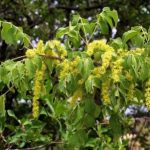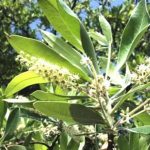TREE LIFE
November 1983
MASHONALAND CALENDAR
Tuesday November 1st : Botanic Garden Walk. Meet in the Car Park at 1645 for 1700 hours.
Sunday November 20th : Auk’s Nest Farm, Beatrice, the home of John and Judy Connolly. We plan to spend our morning exploring a boulder strewn area near a stream which is quite lovely. After lunch on the farmhouse lawn, we intend to investigate ant-hills of which there are plenty. A bus from Harare has been arranged and will leave Monomatapa Car Park at 0900 hours. Fare 5.00.
MATABELELAND CALENDAR
Sunday November 6th : Somerset Estate, a short distance beyond the Hotel Rio where there are numerous Securidaca longepedunculata. There is a good chance they will be in full blossom. It may be hot, so an early start is advisable. Meet at the Rio Hotel at 0830 hours.
Sunday November 18th : Roger Clarke’s slide lecture at the Museum at 2000 hours. See Tree Life 44 for further details.
AYRSHIRE CALENDAR
Tuesday November 29th : The Ayrshire Branch AGM will be held at 1500 hours at Gomo Estate, the home of Mr. and Mrs. Barron. Please contact Benedicta Graves for further directions (Raffingora 0-2822)
BOTANIC GARDEN WALK, 4TH OCTOBER 1983
It was indeed a pleasure to see so many at the Botanic Garden walk, including representatives from various corners of Zimbabwe. Tom Muller conducted the exciting walk as we examined the oleander family, APOCYNACEAE. This is a largely tropical family with distinctive vegetative features which we first noted on Funtumia africana, a sub canopy tree, 35 m, of the Haroni-Rusitu forest. All the APOCYNACEAE have simple leathery leaves with entire margins and are usually arranged in opposite pairs along the stem. Just like the figs, MORACEAE, their thick leaves contain a milk sap and it is from the trunks of numerous members of the APOCYNACEAE that rubber is collected. Funtumia elastica is the chief source of what is commercially known as Lagos or Ire rubber. We were also fortunate to see the scented cream flowers in the leaf axils which help to place the family in the book, see appendix to this note. The APOCYNACEAE have two types of fruit, the first of which was amply illustrated in Funtumia where the fruit consists of two halves, each a narrow, rugby ball connected at the base and running horizontally in opposite directions. These capsules split open and we saw the numerous parachute seeds. F. africana was one of the trees implicated in the undesirable sex change in chickens where all the hens allowed to run on Funtumia wood shavings turned into cocks. Now that Tom has created a suitable microclimate for these trees they are growing well in the low altitude rainforest section.
Alongside the Funtumia is Voacanga schweinfurthii which Tom still expects to find in Zimbabwe as it does occur less than a mile into Mozambique. This tree has no petiole and the leaf base almost envelopes the stem. The trunk is smooth although it looks very compressed – something like a wrinkled elephant’s trunk. The fruit resembles that of the toad tree. We then looked at a small specimen of V. thouarsii which is recorded from the Haroni-Rusitu valley, the recorded specimen having been cut down for identification!

Mascarenhasia arborescens. Photo: Stefaan Dondeyne. Source: Flora of Zimbabwe
Further into the low altitude rain forest section alongside the small stream we came across Mascarenhasia arborescens, an Eastern District species occurring along streams below 1 000 m. Together with the other APOCYNACEAE features this specimen showed a characteristic branching pattern where the stem forks into two equal branches which in turn fork equally again this species produces an inferior quality rubber although M. elastica is grown commercially. Wandering on past the Ensete we were shown the Tabernaemontana ventricosa, the toad tree of rain forest under storeys below 1000 m in Manicaland where it may grow 2-3 m tall. Although it has the APOCYNACEAE fruit in two large smooth halves, the seeds lack parachutes but are embedded in a bright orange pulp which is clearly seen when the fruit splits open. Cheryl and I were excited by small dots of bright orange resin on the ridge between the opposite leaves, but we were even more excited to find these again later in T. elegans, the toad tree common on the banks of the Sabi river. These interpetiolar ridges which produce the resin persist on the stem as annuli on the bare branches. T. elegans has a thick corky bark which we have often noted in the more savanna tree species, unlike the forest toad tree, T. angolensis where the bark is smooth and the fruit enormous, each half up to 20 cm in diameter. T. angolensis also has the resin exudates from the growing stipules although it is more profuse than in the other two and white in colour. The stipules are large structures that envelop the stem. This species occurs as a 20 m tree in the Bunga and Vumba above 1 300 m.
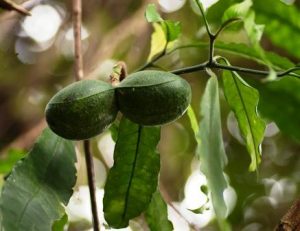
Tabernaemontana ventricosa. Photo: Bart Wursten. Source: Flora of Zimbabwe
Around the back of the forest in the Chrysophyllum gorungosanum grove we came across two exceptions in the APOCYNACEAE. The leaves of Pleiocarpa pycnantha occur in whorls of 3. It is known only from Mt. Selinda and one specimen in the Vumba where it is a medium to understory tree between 1 000 and 1 400 m also with sweetly scented flowers. Rauvolfia caffra also has leaves in whorls, usually in 4 or 5. This pioneer of medium altitude rain forests we often encounter on our travels in Mashonaland. Although it may resemble Breonadia microcephala, RUBIACEAE, we now know to look for the APOCYANCEAE milky sap in order to tell them apart. Rauvolfia would make an ideal garden ornamental if it were not plagued by caterpillars that roll the leaves resulting in an unsightly shrub.
Moving out towards the S.E. lowveld savanna section we came across Adenium obesum, the Sabi Star, in full flower. Although conscious of it being an APOCYNACEAE I had never before seen the impressive double fruit with each horn extending out to 24 cm like an Afrikaner bull. Alongside it the Lundi Star, Pachypodium saundersii displayed its fat spiny trunk. Both of these have the same windblown seeds we saw earlier in Funtumia.
Unfortunately, we were too early to see the flowers on Strophanthus kombe of the lowveld valleys although it is in full flower right now. The narrow yellow petals of this scrambling shrub are almost 6 inches long and hang loosely from the flower tube and get entangled with one another. We did see the horned fruit which can extend 40 cm on each side. S. natalensis is a rainforest liane with shiny green leaves in whorls of 3 unlike S. kombe where the furry leaves grow in pairs. The University botany garden has a large specimen of S. natalensis the numerous pods of which are at present splitting, thus scattering hundreds of the feathery wind blown seeds. Apparently one seed contains sufficient poison to result in death.
Wrightia natalensis is yet another member of that community of coastal trees that extends into Zimbabwe via the deep cretaceous sand of Gonarezhou. The long paired fruit results in the common name of saddle pod. The specimen in the gardens lacked fruit and was only just flushing out in young lanceolate leaves.
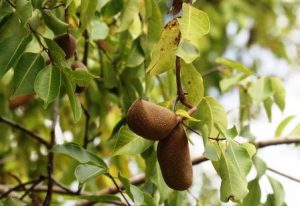
Diplorhynchus condylocarpon. Photo: Bart Wursten. Source: Flora of Zimbabwe
Another member of the family we frequently encounter on our outings is the rubber tree, Diplorhynchus condylocarpon, with its typically hanging branches and shiny green leaves. Although seldom common in the woodland it is at times the only tree of the Dyke where it forms an open scrub land. In future we should note the two horned fruit.
After all the reinforcement of the APOCYNACEAE paired fruit it was quite surprising to arrive at the common Carissa edulis that some of us “pigged” on the recent Palm Block trip. Carissa has that oval dark purple fruit that is so thirst quenching despite the unusual sensation of watching the red flesh curdling with the opaque APOCYNACEAE milk. C. edulis occurs along rivers and on any hills at medium to high altitudes but may be found in woodland. In the other species C. bispinosa the spines as the name implies divide into two. This species extends southwards along the coast and is frequently encountered in the forest around Table Mountain.
Another indigenous genus with an unpaired fruit is Acokanthera, the poison bush. Our treasurer, Brian Best, informs us of a recent revision of this genus. The first plant we examine, Acokanthera schimperi var. rotundata has been upgraded to a species on its own, A. rotundata so that the real A. schimperi now extends from Yemen to Zaire. A. rotundata, therefore, occurs in the Matopos and Bikita areas and has a broader leaf with more obscure secondary veins when compared to A. oppositifolia. The latter we saw in full flower at Mazowe Dam wall in September. Many Acokanthera species have been widely used as arrow poisons as they contain ovabain, a cardiac glycoside that is still widely used in experimentation with membranes, particularly in frog skin research as it blocks the little sodium and potassium pumps on the membranes that are responsible for water uptake. Frogs, by the way, only drink water through their skins and never swallow. Similar pumps occur throughout our body and so any chemical that blocks them will lead to death. Molecules of cyanide and strophanthus also function in this way. Tom swears the ripe fruit is not only edible but very tasty. When Brian Best was chemically analyzing local plants for cardiac glycosides he was unable to prove their existence in these fruit although I am not personally advocating eating them.
Landolphia is not strictly a tree but rather a liane. Two local species occur and the test on vegetative characters relies on breaking a branch and sucking out the milky latex. If this results in a mouthful of chewing gum, the plant is L. kirkii which grows in forests below 1 000 m. As we looked at L. buchananii, which grows from 1 000 to 1 500 m and fails to produce a chewing gum we failed to attempt the test but observed its tennis ball sized unpaired fruit. Several of the Landolphia species are grown commercially for what is known in the trade as African and Madagascar rubber.

Holarrhena pubescens. Photo: Colin Wenham. Source: Flora of Zimbabwe
There were only two species we failed to see before being enveloped by night, the widespread jasmine tree Holarrhena pubescens and Oncinotis inandensis a shrub or forest liane with a restricted distribution. An interesting walk, thank you Tom; we continue to be impressed by the diversity you have managed to create in a comparatively small area.
APPENDIX TO THE BOTANIC GARDEN WALK : For those interested in finding their way around the books and local herbaria here is some background to the APOCYNACEAE I left out of the actual notes. Plants as we know are arranged according to floral features and the distinctive characteristics we saw on the walk were : Firstly the petals are fused into a tube which places the family somewhere after the ERICACEAE, page 711 in Coates Palgrave, 177 edition. Secondly the ovary is superior so it must be before the RUBIACEAE, page 838. Within these hundred odd pages the families run from those with only radially symmetrical flowers like the APOCYNACEAE to those with bilateral symmetry like the pink jacaranda, BIGNONIACEAE. Amongst the flowers with radial symmetry the APOCYNACEAE is one of a small group of families where each petal overlaps the next one in a spiral pattern. This is known as confolute arrangement and is also seen in the morning glory, CONVOLVULACEAE. To tie in the vegetative characters, all the families near the beginning of this group have simple leaves, whereas the later families particularly those with bilaterally symmetrical flowers have compound leaves, e.g. BIGNONIACEAE.
-Kim ST.J.Damstra
OUTING TO SAFFRON WALDEN, SUNDAY 16TH OCTOBER 1983
A mostly overcast sky and a cool breeze ensured that despite the fact that it was October not too many Harare members wilted while scaling the granite kopjes at Saffron Walden.
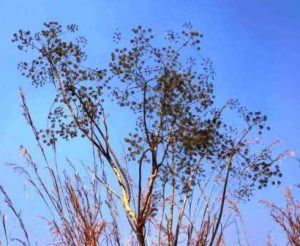
Steganotaenia araliacea, Photo: Bart Wursten. Source: Flora of Zimbabwe.
We started our day on Dick Petheram’s suggestion at the Northern end of the kopjes. Before going uphill we examined what was to be seen at the foot of the hills. We first noticed a Pterocarpus angolensis, mukwa, coming into yellow flower, but still carrying its “hairy fried egg” pods from last year. Close by were a couple of smallish Kigelia africana, sausage tree, in new fresh green leaf, but no flowers or fruit. We were then treated to the sight of Turraea nilotica going through the whole range from fresh new flowers to ripe fruit consisting of several black seeds partly covered with a red aril in an open capsule. These are reminiscent of a similar arrangement in the Natal mahogany, Trichilia emetica, which is possibly not so surprising as both belong to the family MELIACEAE. A little further along was an exceptionally large Steganotaenia araliacea, with no leaves but plenty of seed carried parsley and carrot style, characteristic of the family APIACEAE, Umbelliferae.
In this area, Azanza garckeana, Vitex payos, Ozoroa insignis, Pseudolachnostylis maprouneifolia and Cassia abbreviata with the beginnings of pods were also found
Close up against the lowest boulders were both Rhus longipes and R. leptodictya, mountain rhus, the former being a rather round leafed rhus and rather velvety to feel, while the latter is a glabrous and narrower leaflet, though not so much as the more common R. lancea.
Amongst the boulders of the lower slopes of the kopje was a grove of Afzelia quanzensis. Quite leafless a month ago when seen on the recce, they were now fully covered in fresh green leaves, but the most exciting feature was that it was in flower as well. For most of us this was a first. It is a strange flower for it has only a single large red petal. On the ground below the tree were pods from the previous season. One or two members were lucky enough to find a couple of black seeds complete with a red aril partly enclosing the lower end. The small number of seeds located is supposedly accounted for by the hornbills which apparently collect the seed for the arils, and thus dispersing the seed.

Ochna schweinfurthiana. Photo: Jos Stevens. Source: Flora of Zimbabwe
A little higher up, Ochna schweinfurthiana was covered in flower and fruit. Next to it a leafless, flowerless tree was betrayed by the dead shaving brush flowers scattered on the ground, as Albizia antunesiana. Higher up we saw the first of many sizeable and probably very old Diospyros natalensis with tiny round leaves leading to the popular name of “tickey tree”. Another inhabitant of the granite kopjes we found was Erythroxylum emarginatum. The leaves of this tree crackle when folded and have a notch at the tip of the leaf in accordance with the specific name. Another clue to its identity is the succession of persistent stipules on some of the twiglets giving it the appearance of scaly ‘lizard legs’.
Next to a flowering Burkea africana was a good specimen of Garcinia buchananii in green fruit. The aspirations of Meg Coates Palgrave to photograph its flower in situ were dashed by the Chairman who thoughtlessly picked the only remaining specimen to show around to members. The flower stalk is almost non-existent so the flower appears almost stuck onto the branch. It is a pale yellow flower with a sticky orange centre.
Nearing the top of the kopje was Rothmannia fischeri. This belongs to the family RUBIACEAE and has opposite leaves with an interpetiolar stipule. The leaves tend to be crowded at the ends of the branchlets. Often one of a pair of leaves is aborted and one is fooled into thinking the leaves are in threes. This first specimen we saw had quite roundish, furry leaves while another we saw later was completely glossy and more lanceolate in shape.
Bob Drummond at the National Herbarium informed us that this dichotomy, where totally glabrous specimens occur with distinctly furry specimens of the same species is common in the RUBIACEAE.
The rarity of the day was Nuxia congesta seen at the top of the kopje. We saw the remains of the flower heads and noted the leaves appearing in whorls of 3, crowded at the ends of the branches. The ones we saw had rather soft velvety leaves with an irregularly coarsely toothed margin. The distribution map does not show this occurring here.
Coming down from the kopje we saw the paper barked Commiphora marlothii in flower and C. africana in fruit. At the foot of the kopje we saw the zig-zag branched Euphorbia matabelensis and next to each other for easy comparison Ficus sur and F. sycomorus.
After a lazy lunch under the Afzelias we embossed and went back to the south-west corner of the kopjes. We then saw a large Kigelia africana, this time with a single large flower for us to admire. The inner surface is a rich burgundy colour with a velvety texture. Then, proceeding up into some low kopjes we came across a truly gigantic Ficus ingens. This had evidently once been a single trunk but had split into two possibly because of fire – due to honey collectors? We then found a specimen of another rarity Erythrococca trichogyne, which was found on the last trip to this locality. Unfortunately, no flowers or fruit were seen this time.
Further round, near another enormous fig was a leafless specimen of Pouzolzia hypoleuca which we usually see as a smallish bush. Well, this one was really a respectable tree probably 4 m in height.
Coming down from the rocks we emerged onto the flat ground and walked over to see another glorious sight. This was the violet tree, Securidaca longepedunculata, in full flower. Once on the leeward side of these trees the deliciously sweet scent was almost intoxicating.
So with the heady fumes of Securidaca still in our lungs we boarded the bus after a most enjoyable day.
-Kim St.J. Damstra
MATABELELAND NOTES
About twenty members of the Association of University Women joined us for our outing on Sunday, 2nd October. We took them to a kopje in the Baronvale area which meant scrambling over very rocky terrain, but they all took the keenest interest in what we could tell them of the trees. Most trees were still bare, but we found several in flower which added to their attraction. We started off with a group of Albizia antunesiana in beautiful bloom, with new pinkish bronze leaves among the blossom. Right next to these were several Albizia amara, just coming into flower. A Securidaca longipedunculata was full of bud, with one or two flowers already out, and this came as a joyful surprise to our guests, to most of whom the tree was entirely new. We found blossom on Carissa edulis and on Maerua juncea. There was a good specimen of Mimusops zeyheri, which they ought to recognize when next they are in the Matopos, and an Olea europaea subsp. africana, the wood of which they of course knew, carved by the Africans into figurines and sundry articles. On the return, driving through Waterford, we stopped to look at a Trichilia emetica in full bloom. At Mrs. Phyllis Kabot’s invitation we went to her home at Lakeside for tea, after which we wandered in her garden. We found a Turraea nilotica in bloom and a magnificent specimen of Ficus natalensis, full of fruit. Our guests, I think, enjoyed the outing. Dare we hope for some new members from among them?
-Dora Webb
ROOT NOTE: We would all like to congratulate our energetic secretary of the Ayrshire Branch Mrs. Benedicta Graves who has recently been awarded the South Ayrshire Oscar, a floating trophy of a handsome gem stone tree. Dicky who is always so enthusiastic and encouraging was presented this award for her work as a conservationist and for being a prime mover in the local branch of the Tree Society.
-Kim St.J. Damstra
PHILLIP HAXEN, CHAIRMAN


